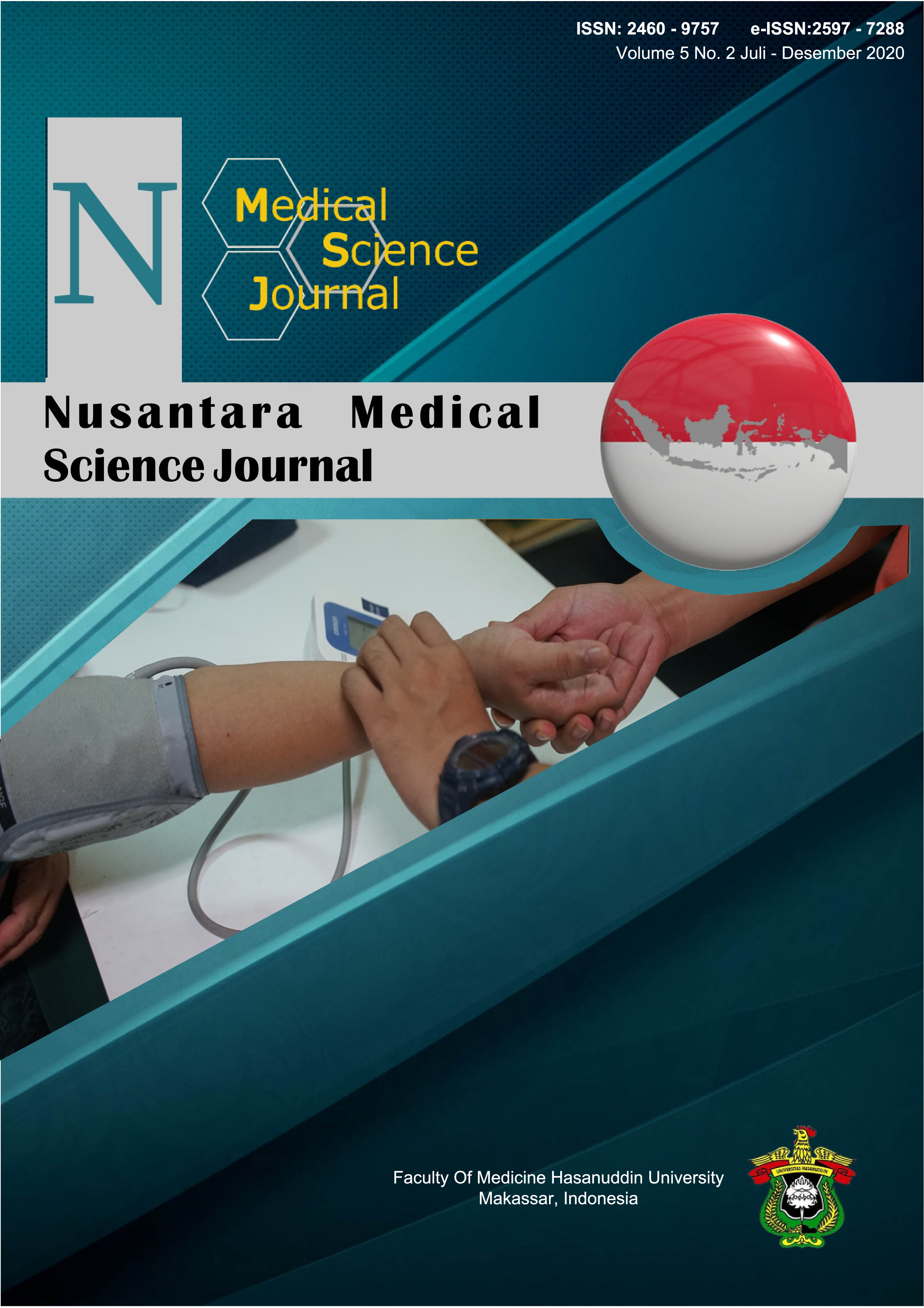Perbandingan Remifentanil Kontinu 0.15 Mcg/Kgbb dengan Fentanyl 3 Mcg/Kgbb pada Intubasi Endotrakeal Diukur Menggunakan Pupillometer (AlgiScan®)
Article History
Submited : May 4, 2020
Published : April 5, 2021
Keywords:
Introduction: All opioids have varying levels of sedative effects with increasing dosages, although with different strengths. Therefore, the opioid component as a sedative regiment is usually maintained at minimum dose for adequate analgesic with regard to patient comfort. Along with the progress of knowledge, parameters have been found to measure the level of analgesic and sedative. Methods: The principle of measurement is done by using the diameter of pupil and then analyzed through AlgiScan and compared to certain standards. The using of pupilometers AlgiScan in assessing the level of sedative analgesic will reduce the level of subjectivity and errors in measurement. Results: The use of Remifentanil has a faster effect of sedative as proven by lower “AlgiScan” score in the pre-intubation phase. In addition, the use of Remifentanil also provides a hemodynamic view of lower arterial pressure, both pre and post intubation condition. Conclussion: Both Remifentanil and fentanyl are able to provide analgesic with sedative and stable hemodynamics. Remifentanil is proven to be superior with better and faster effect and also faster substance elimination with lower doses.
References
- Morgan GE, Michail MS, Murray MJ (2006). Local Anesthesia. Clinical Anesthesiology. 4thed. New York: Mc Graw-Hill; 263-75.
- Kaye KW. Changing trends in urology practice: increasing outpatient surgery. Austr New Zealand J Surg 2015;65(1):31
- Glass PS, Hardman D, Kamiyama Y, Quill TJ, Marton G, Donn KH, et al. Preliminary pharmacokinetics and pharmacodynamics of an ultra-short-acting opioid: L Remifentanil (GI87084B). Anesth Analg 2013;77(5):1031-40.
- Douma MR, Verway RA, Kam-Endtz CE, van der Linden PD, Stienstra R. Obstetric analgesia: a comparison of patient-controlled meperidine, Remifentanil, and fentanil in labour. Br J Anaesth 2010; 104: 209-15.
- Stoelting RK, Hillier SC (2006). Local Anesthetics. Handbook of Pharmacology and Physiology in Anesthetic Practice 2nded. Philadelphia: Lippincott Williams And Wilkins; 7: 180-209.
- Balcioglu O, Akin S, Demir S, Aribogan A. Patient-controlled intravenous analgesia with Remifentanil in nulliparous subjects in labor. Expert Opin Pharmacother 2007; 8: 3089-96.
- I Constant., et al. “Reflex pupillary dilatation in response to skin incision and alfen-tanil in children anaesthetized with sevoflurane: a more sensitive measure of noxious stimulation than the commonly used variables”. British Journal of Anaesthesia 96.5 (2006): 614-619.
- Park HP, Hwang JW, Park SH,Jeon YT, et.al (2007. The Effects of Glossopharyngeal Nerve Block on Postoperative Pain Relief After Tonsillectomy, The Importance of the Extent of Obtunded Gag Reflex as a Clinical Indicator. Anesth Analg J. Med; 105 (1): 267-71
- Rudra A (2005). Airway Management in Obstetric. Indian J. Anesth; 49(4): 328-35.
- Tewari P, Gupta D, Kumar A, Singh (2005). Opioid Sparing During Endotrakheal Intubation Using Mccoy Laryngoscope In Neurosurgical Patient: The Comparison Haemodynamic Change With Macintosh Blade. J. Postgrad Med; 51(1): 260-5.
- Hagberg C, Georgi R, Krier C (2005). Complication of Managing the Airway Responses to Intubation. Best Practice And Research Clinical Anaesthesiology. USA: Elsevier; 7: 641-69.
- Finucane BT, Tsui BCH, Santora AH (2011). Anatomy of the Airway. Principles of Airway Management 4th ed. New York: Springer; 1: 10-7.
- Orebaugh, Steven L (2007). Atlas of Airway Management: Technique and Tools. 1st ed. Lippincott Williams and Wilkins; 1-6.
- Calder I, Pearce A (2005). Tracheal intubation of the Adult Patient. In
- Talmage,et al. (2001) Remifentanil Pharmacokinetics and Pharmacodynamics. Unversity of Utah school of medicine.
- Ben et al. (2016) Remifentanil use in Anaesthesia. and Critical Care. Anasthesia tutuorial of the week.
- Minto F Charles. (2007). Pharmacokinetics and Pharmacodynamics of Remifentanil. American Society of anesthesiologist
- Melljeans et al. (2003). Remifentanil versus fentanil for analgesia based sedation to provide patient comfort in the intensive care unit: a randomized, double-blind controlled trial.
- Somers TJ, Kurakula PC, Criscione-Schreiber L, Keefe FJ, Clowse MEB. Self-efficacy and pain catastrophizing in systemic lupus erythematosus: relationship to pain, stiffness, fatigue, and psychological distress. Arthritis Care Res. 2012;64:1334–40
- M Larson., et al. “Pupillary response to noxious stimulation during isoflurane and propofol anesthesia”. Anaesthesia and Analgesia 76.5 (1993): 1072-1078.
- S Isnardon., et al. “Pupillometry to detect pain response during general anaesthesia following unilateral popliteal sciatic nerve block”. European Journal of Anaesthesiology 30.7
- Alirez Pournajafi, et al. Endotrach al Intubation in Preeclampti Parturient Candidate for Cesarea Delivery. Anesth Pain. 2012;2(2):90-93. DOI: 10.5812/aapm.688
- Bernd Muellejans et al. Remifentanil versus fentanil for analgesia based sedation to provide patient comfort in the intensive care unit: a randomized,double-blind controlled trial [ISRCTN43755713]. Critical Care 2004, 8:R1-R11 (DOI 10.1186/cc2398)
- Cevik, M. Celik, P. M. Clark, and C.Macit. Sedation and Analgesia in Intensive Care: A Comparison of Fentanil and Remifentanil. Hindawi Publishing Corporation Pain Research and Treatment 2011. doi:10.1155/2011/650320
- Karabinis A, Hantson P, Speelberg B, Stergiopoulos S, Illievich UM, Maas A, Upadhyaya BK: A Remifentanil-based techniquefor analgesia and sedation in ICU patients with neurotrauma: preliminary data [abstract A549]. Intensive Care Med 2001, Suppl 2:S275.
- Jhon Guy MD, et al. Comparison of Remifentanil and fentanil in patients undergoing craniotomy for supratentorial space occupying lesion. 2007. American association of anesthesiologist.
- Q.-Y. Yang, F.-S. Xue, X. Liao et al., “Comparison of bolusre remifentanil versus bolus fentanil for blunting cardiovascular intubation responses in children: a randomized, double-blind study,” Chinese Medical Journal, vol. 122, no. 1, pp. 44–50,2009.
- Mangano DT, Siliciano D, Hollenberg M, et al. Postoperative myocardial ischemia. Therapeutic trials using intensive analgesia following surgery. The Study of Perioperative Ischemia (SPI) Research Group. Anesthesiology 2012; 76: 342±53.
Bachtiar Amin, F., A.A Husain, A., Musba, A. M. T. ., & Ahmad, M. R. . (2021). Perbandingan Remifentanil Kontinu 0.15 Mcg/Kgbb dengan Fentanyl 3 Mcg/Kgbb pada Intubasi Endotrakeal Diukur Menggunakan Pupillometer (AlgiScan®). Nusantara Medical Science Journal, 5(2), 71-79. https://doi.org/10.20956/nmsj.v5i2.9912
Copyright (c) 2021 Array

This work is licensed under a Creative Commons Attribution 4.0 International License.
Downloads
Download data is not yet available.
Fulltext
